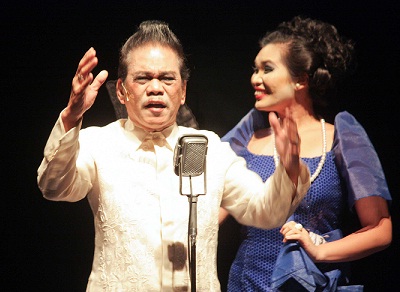By PABLO A. TARIMAN
FOR sure, theater audiences will have different ways of reacting to Mario O’Hara’s “Stage Show” which will open the National Theater Festival on November 7 and 8.
For the new generation, this play is an opener and a curious but another insightful look at this country’s practitioners of live entertainment. From the way the play unfolded through song and dance, they will surely know what their grandparents’ generation enjoyed and how these entertainers hang on to their art as their means of survival.
The competent set designs of Tuxqs Rutaquio and the costume design of Brenda Fajardo easily transported the audience to that era of live entertainment and enhanced by the superb lighting of Katsch Catoy. The choreography of Denisa Reyes remained faithful to the dance movements of that period while giving them a new updated look for the present generation.
Like it or not, “Stage Show” was this generation’s baptism of entertainment before they got hooked on Justin Bieber and Lady Gaga.
For theater-goers in their 60s, 70s and 80s, “Stage Show” is one hell of nostalgia trip to that bucolic time when entertainment could be had not just in formal venues but in the town plazas as well, in the ubiquitous peryas and the visiting circus during town fiestas.
This is the reason why Tanghalang Pilipino invited living personalities associated with those shows now rarely seen in the city and even in provinces.
 Indeed, this popular entertainment genre from 1920s to mid-‘60s, gave birth to legendary talents like Dolphy, Bayani Casimiro, Rogelio dela Rosa, German Moreno, Sylvia La Torre, Pilita Corrales, Elizabeth Ramsey, Oscar Obligacion, Chichay and the tandem of Pugo and Tugo, among others.
Indeed, this popular entertainment genre from 1920s to mid-‘60s, gave birth to legendary talents like Dolphy, Bayani Casimiro, Rogelio dela Rosa, German Moreno, Sylvia La Torre, Pilita Corrales, Elizabeth Ramsey, Oscar Obligacion, Chichay and the tandem of Pugo and Tugo, among others.
With the play opening with the rendition of “Mambo, Mambo Magsaysay,” you get to realize that the play is indeed set in the 1950s when the country was still largely a peasant society, according to director Chris Millado.
Millado elaborated on that socio-political milieu in his director’s notes: “The post-war years signaled the start of the aggressive ‘cold war’ propaganda of the US and propelled the CIA-backed Magsaysay presidency. The escapist antics of the stage show and the vaudeville drove a cultural wedge between the Filipino and his recent revolutionary past – one that resisted colonialism through symbolist zarzuelas and seditious dramas; and producing new natives convulsing in the new rhythms of consumerism and the American dream.”
And so when “Stage Show” opened, you get to see the varied performers and assorted acts labeled as Tirso (played by Nonie Buencamino) and the Bandits, Tres Dahlias (one of them is Shamaine Centenera Buencamino) and the Titina Trompeta, among others.
Between song and dance and between comedy and drama skits, the love story of Tirso (Buencamino) and Ester (Centenera) unfolds. Tirso makes a living in a ragtag band and Ester survives through her stint with the Tres Dahlias. They love what they are doing that most of the time, money was never an issue. The subject of money re-appears when the entertainers cope with hospital bills and eventually, funeral expenses.
 Towards the end of the play, you get to realize how these entertainers live their lives, how they reckon with uncertainties of their job (they incorporate them in their comedy and drama skits) and how — in the end — they accept their fate.
Towards the end of the play, you get to realize how these entertainers live their lives, how they reckon with uncertainties of their job (they incorporate them in their comedy and drama skits) and how — in the end — they accept their fate.
O’Hara has so intelligently woven this play so that it entertains while the hapless lives of entertainers are honestly told without a hint of self-pity.
Like it or not, the play is a parable of the Rise and Fall of Live Entertainment in the country. Its main attraction are the competent actors namely Angelina Kanapi (as Chabeng), Mae Paner (Magdea), Rody Vera (as Bobby Gonzales), Rayna Reyes (as Caridad) and Lou Veloso (as the Meyor/Pulubi) and the other members of an excellent ensemble.
The acting team of Buencamino (as Tirso) and Centenera (as Ester) superbly blended with the ensemble while remaining admirable in their individual roles. Buencamino’s musical genes (his great grandfather, Francisco Buencamino, used to do live music for silent films screened at theaters along Rizal Avenue) probably helped him absorb the part with great relish and palpable pathos. For her part, Centenera carved her role with delicate nuances and in the end you conclude that — although films and teleseryes benefit from her talent – her best moments are still on the theatrical stage.
Chris Millado was able to explore the heart and soul of the O’Hara play with great sensitivity.
“It took a great exploration during the rehearsal stages to figure out the flashbacks and disentangle the narrative from the routine before gingerly putting them back together. Mario O’Hara has left a riddle for the actors to solve. I was very fortunate to work with Nonie Buencamino and Shamaine Centenera who contributed — in a tremendous way — in mapping out the journey that the playwright wanted us all to take,” he shared how he achieved his theatrical goal for the play.
